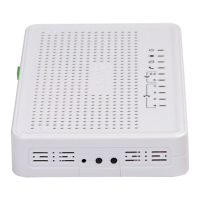____________________________________________________________________________________
____________________________________________________________________________________
NTU Optical Network Terminals 17
3 ARCHITECTURE OF DEVICES
3.1 NTU-RG architecture
Figure 8 – Logical Architecture of a Device with Factory Settings
Main Components of the Device:
– optical receiver/transmitter (SFF module) for conversion of an optical signal into electric one
– processor (PON chip) which converts Ethernet and GPON interfaces; and
– Wi-Fi modules for wireless interfaces of the device.
A device with factory (initial) settings have the following logical blocks (see Figure 8):
Br1;
Voice (IP telephony);
eth0…3;
FXS0;
wl0, wl0.1..wl0.3, wl1, wl1.1..wl1.3;
ppp0.1;
IPInterface.
The br1 block here is used to combine LAN ports into a single group.
The eth0..3 blocks physically represent Ethernet ports with RJ-45 connector for connection of PC, STB,
and other network devices. They are logically included into the br1 block.
The FXS0 block is a port with RJ-11 connectors for connection of analogue phone. It is logically included
into the Voice block. The Voice block can be controlled through web interface or remotely with ACS server via
TR-069 standard. The block specifies VoIP service parameters (SIP server address, phone number, VAS, etc.).
The wl0, wl0.1…wl1.3 blocks are the Wi-Fi module connection interfaces. wl0 blocks are the interfaces
designed for 2.4GHz band operation and wl1 blocks are designed for 5GHz band operation.
Filter and Marking blocks enable inclusion of local interfaces into a single group (to br1 block). They deal
with the traffic transmission rules, Filter blocks are responsible for the incoming traffic on the interface, Marking
blocks—for the outgoing one.

